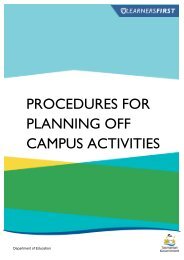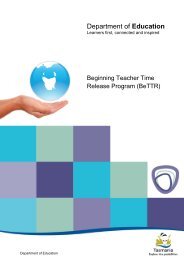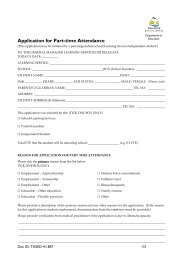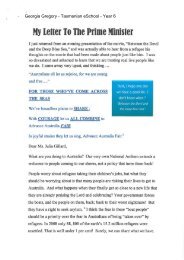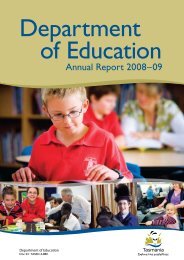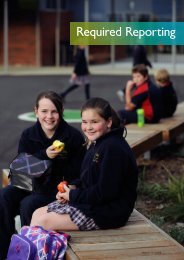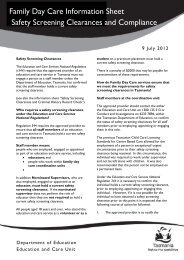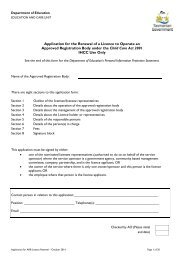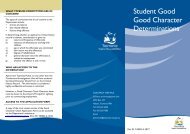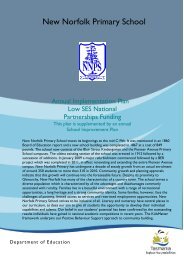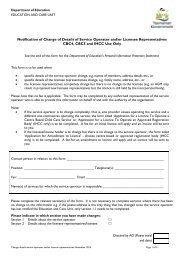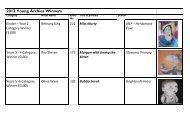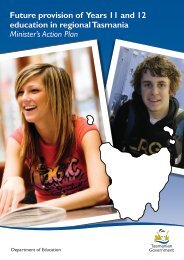Education
DoE Annual Report 2012-2013 - Department of Education
DoE Annual Report 2012-2013 - Department of Education
- No tags were found...
Create successful ePaper yourself
Turn your PDF publications into a flip-book with our unique Google optimized e-Paper software.
Closing the<br />
Gap on<br />
Aboriginal<br />
<strong>Education</strong><br />
Outcomes<br />
The Tasmanian Closing the Gap in Aboriginal <strong>Education</strong>al<br />
Outcomes (2010-2014) Strategy complements work through<br />
the Smarter Schools National Partnership for Literacy and<br />
Numeracy to lift the performance of Aboriginal students.<br />
The Tasmanian Closing the Gap Strategy reflects the priority<br />
actions of the National Aboriginal and Torres Strait Islander<br />
<strong>Education</strong> Action Plan (NATSIEAP) which aims to build<br />
the capacity of schools to meet the educational needs of<br />
Aboriginal students and accelerate performance through<br />
whole of school approaches to personalised learning,<br />
literacy and numeracy improvement and community<br />
engagement.<br />
A feature of the strategy is the identification of 61 focus<br />
schools, based on high Aboriginal student enrolment and<br />
high educational need, which receive additional support<br />
from the department through Aboriginal <strong>Education</strong><br />
Services (AES). Focus schools are receiving specialised<br />
support from AES to support inclusive teaching and<br />
improve community engagement. In 2012, all focus schools<br />
were recipients of additional funding to provide targeted<br />
programs and support for Aboriginal students.<br />
While Tasmanian schools compare well, Aboriginal<br />
students achieve lower learning outcomes than their<br />
non-Aboriginal peers. Strategies designed to close this<br />
gap include: in-class tuition, personalised mentoring and<br />
tutoring, and support for speech and hearing. Professional<br />
learning for tutors and cultural awareness is also provided.<br />
The NATSIEAP enabled extension funding of $1.9 million<br />
to support five NATSIEAP focus schools to incorporate<br />
the Raising the Bar Closing the Gap strategy into their<br />
schools—Raising the Bar Closing the Gap Indigenous<br />
extension. This program concluded at the end of 2012.<br />
Further funding in late 2011 of $1 million over two years<br />
through the Next Steps program has enabled another<br />
five focus schools to support their Aboriginal students.<br />
In June 2012, a new partnership agreement titled<br />
Investing in Focus Schools was signed. A further eight focus<br />
schools receive funds totalling $1.2 million to support the<br />
improvement of Aboriginal student outcomes through<br />
this program.<br />
Literacy and<br />
Numeracy<br />
National<br />
Partnership<br />
schools<br />
Whilst funding for the Smarter Schools National Partnership<br />
for Literacy and Numeracy finished at the end of 2011,<br />
literacy and numeracy remain departmental priorities<br />
and both National Partnership (NP) and non-NP schools<br />
continue to implement strategies to improve the literacy<br />
and numeracy outcomes of all students. The department’s<br />
Literacy and Numeracy Framework introduced in 2012<br />
supports improved student outcomes in literacy and<br />
numeracy. Based on the framework, every school has an<br />
explicit literacy and numeracy strategy as part of their<br />
school improvement plan so that every child’s literacy and<br />
numeracy learning needs can be supported.<br />
To empower inspiring leaders within networks to enhance<br />
literacy and numeracy teaching, the department initiated<br />
a Lead School/Lead Teacher strategy in 2012. Network lead<br />
teachers, based in each lead school, provide leadership,<br />
direction and high level support to all principals and<br />
schools across the network in the implementation of<br />
the Literacy and Numeracy Framework. Lead schools and<br />
lead teachers of literacy and numeracy work across the<br />
networks of schools to mentor and coach and to build the<br />
capacity of teachers to teach literacy and numeracy.<br />
Building the capacity of teachers to effectively use data<br />
to inform their planning and deliver quality literacy and<br />
numeracy opportunities for students has continued<br />
to increase. In 2013, ‘Working with Data’ professional<br />
learning opportunities are provided to principals and<br />
teachers through the Professional Learning Institute<br />
(PLI). The NAPLAN Toolkit, a resource for classroom<br />
teachers, developed by the department, allows classroom<br />
teachers to view, sort and analyse students’ NAPLAN<br />
data and to access links to relevant teaching strategies<br />
to support improved student performance. Relevant<br />
reports and data provided to schools through <strong>Education</strong>al<br />
Performance Services (EPS) assist schools to better<br />
determine targets for whole school improvement and<br />
student performance.<br />
In 2013, 51 government schools are participating in the<br />
Improving Literacy and Numeracy National Partnership.<br />
Participating schools are implementing the Raising the Bar<br />
strategy. Teachers are focusing on collaborative planning<br />
and effective evidence-based practice to inform their<br />
planning and delivery of quality literacy and numeracy<br />
opportunities to improve student outcomes.<br />
32 Pre-Compulsory and Compulsory <strong>Education</strong> » Literacy and Numeracy




